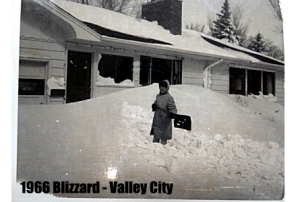 Bismarck (CSi) North Dakota Governor, Doug Burgum has proclaimed October 29- November 2 as Severe Winter Weather Awareness Week in North Dakota.
Bismarck (CSi) North Dakota Governor, Doug Burgum has proclaimed October 29- November 2 as Severe Winter Weather Awareness Week in North Dakota.
Winter in North Dakota can be very unpredictable and the severity can change quickly.
On Friday’s Wayne Byers Show on CSi Cable 2, Stutsman County Emergency Manager, and 9-1-1 Coordinator, Jerry Bergquist pointed out the terminology used by meteorologists and weather, forecasters, and preparing for winter storms.
- An ADVISORY – is issued when winter weather is possible, but not hazardous enough to meet WARNING criteria.
- A WINTER WEATHER ADVISORY – is issued for accumulations of snow, freezing rain, freezing drizzle and sleet which will cause significant inconveniences and could lead to life-threatening situations. The criteria is three to five inches of new snow in a 12 hour period of time
- A WIND CHILL ADVISORY – is issued for wind chills of 25-39 degrees below zero, Fahrenheit.
- A WATCH – is issued when bad weather is possible in the area.
- A BLIZZARD WATCH – is when the conditions are favorable for a blizzard in the next 24 to 72 hours.
- A WARNING – indicates imminent danger to life and property. The snow fall criteria is six to eight inches of new snow within a 24 hour period of time.
- An ICE STORM WARNING – is when the ice from freezing rain is ¼ inch thick or greater and may cause danger to life and property.
- A WIND CHILL WARNING – is issued for wind chills of 40 degrees below zero, Fahrenheit or colder.
- A BLIZZARD WARNING – is issued for sustained or gusty winds of 35 mph or more, and falling or blowing snow creating visibilities at or below ¼ mile; these conditions could persist for at least 3 hours.
BE PREPARED
The best way to protect you, your family, and your property is to be prepared.
- Make a plan – this includes escape routes, meeting places, how you will communicate if not together, special needs that may take extra planning, pets, and any vital records you may need with you such as insurance. *
- Build an emergency supply kit – this should include enough supplies to sustain you and your family for at least 3 days. *
- Keep an emergency supply kit in your vehicle – make sure to include extra cloths and blankets in your vehicle. *
- Winterize your home – this may include insulating water pipes, installing batter operated carbon monoxide detectors, maintain heating units, and keeping fire extinguishers on hand.
- Be aware of travel alerts and advisories – make sure that rad conditions are safe for traveling before you venture out on the roads. (www.dot.nd.gov/travel)
- A Travel Alert – is issued when areas of challenging winter driving conditions may be encountered on roadways. Motorists can still travel, BUT, they should be aware that rapidly changing conditions may result in travel delays due to reduced speeds and visibility.
- No Travel Advisories – are issued when conditions warrant no travel but not a road closure. These have the potential to change to a Road Closure if conditions deteriorate.
- Roads Closed or Blocked – are issued when roadways pose life threatening conditions. The road(s) may be impassible or blocked. Motorists who drive past road closure devices may be fined up to a $250 fine
* For more information go to: www.co.stutsman.nd.us/files/emergency-guide.pdf or www.fema.gov/prepare












Comments are closed
Sorry, but you cannot leave a comment for this post.